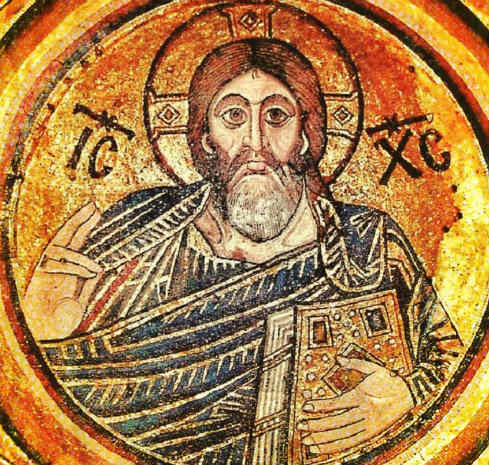100 Greatest Painters Artists Alphabetically Artists by Country Artists by Century Artists by Movement
500-1450

The Byzantine school of painting emphasized transcendent time and place; the only worldly concern was with how one must behave in order to get into heaven. Thus the figures in Byzantine art tend to "hover" in space without weight and solidness, without inhabiting a three-dimensional space.
According to Medieval historian, Julia De Wolf Addison, "The garments worn by the Byzantines were very ornate; they were made of woven silk and covered with elaborate devices. In the fourth century the Bishop of Amasia ridiculed the extravagant dress of his contemporaries. "When men appear in the streets thus dressed," he says, "the passers by look at them as at painted walls. Their clothes are pictures, which little children point out to one another. The saintlier sort wear likenesses of Christ, the Marriage of Galilee, Lazarus raised from the dead." Allusion was made in a sermon: "Persons who arrayed themselves like painted walls" "with beasts and flowers all over them" were denounced!"
The monasteries owned vast libraries and engaged in the copying of manuscripts. Manuscript paintings were generally styled after classical paintings of late antiquity.
Byzantine mosaics are bedecked with gold leaf and iridescent glass tiles, radiating a shimmering, heavenly light. The effect of the composition together with the precious materials, lift the holy figures into a divine spiritual place. The figures themselves are symmetrical, repetitive, and little emotion or individualism is expressed in their calm faces.
Throughout the life of the Byzantine Empire, the Eastern Orthodox Church also played an important social role. Sacred images, commissioned by the church acted as moral instruction to the illiterate peasants who clamored for enlightenment of the holy scriptures.
Until the twelfth century it had been the custom to adorn the alters with costly religious reliquaries wrought in metal; partly to preserve the metallic sheen of the decoration, partly because of the contiguity of mosaics or stained glass, the paintings had to make the most glittering impression possible. The figures, therefore, are raised like mosaics from a gold background. Red, blue , and gold are the prevailing colors. The figures also have the solemnity of Byzantine types. The head of the Madonna, with the large almond eyes and long, pointed nose, and the indifferent manner in which she holds the Christ Child with her elongated, bony hands.
With the triumph of Christianity, Byzantine artists aspired to reawaken the divine spirit of holy figures rather than depict their physical qualities. Their luminous paintings captured the spirit of the Bible and helped to popularize Christianity.
Their unique style is a combination of depicting frontal simplicity, sacred images, harmonious unity, together with precision in details. The use of costly materials such as gold, precious stones and ivory indicates the degree of wealth that was common during this period, and attests to the sophistication of the Byzantine Society.
The Meaning of Sacred Symbols in Paintings. Most prominently featured symbols and their meaning:
☼☼☼☼☼
Important Words, People, Phrases, Characteristics related to the Italian Renaissance Art Movement - rebirth, rediscovery of the classical world, City-state, Humanism, Humanist, Francesco Petrarch, Reform, The Prince, Theocracy, The Inquisition, Human Reasoning, Medici Academy, publication of Della Pittura, a book about the laws of mathematical perspective for artists, sfumato, chiaroscuro, linear perspective, Heliocentric Theory, Petrarch, Baldassare Castiglione, The Book of the Courtier, liberal arts, civic humanism, Verrocchio, secularism, Leonardo Bruni, Lorenzo Valla, Neo-Platonism, nominalism, Giotto, Masaccio, Botticelli, Quattrocento, vanishing point, Savonarola, oligarchy spiritually significant, illuminated manuscript, idealized biblical themes, scriptorium, emotion, illuminator, iconoclast, Michelangelo and Leonardo Da Vinci, Age of Discovery, axonometric drawing, curiosity about the natural world, mythology, realistic use of colours and light, Bonfire of the Vanities, Old Testament stories, ethereal and foggy backgrounds, Gospel parables, The Blackdeath, romanticized landscapes, Christian symbolism. Paradise
☼☼☼☼☼
If you feel you have worthwhile information you would like to contribute we would love to hear from you. We collect essential biographical information and artist quotes from folks all over the globe and appreciate your participation. When submitting please, if possible, site the source and provide English translation. Email to historyofpainter@gmail.com
© HistoryofPainters.com 2017
If you like this page and wish to share it, you are welcome to link to it, with our thanks.
Princple Painters of the Byzantine Era
Cimabue
Coppo
Di Marcovaldo
Dionysius
Duccio
di Buoninsegna
Jacopo
Di Cione
Ambrogio
Lorenzetti,
Pietro
Lorenzetti
Lippo
Memmi
Andrea
Di Orcagna
Andrei
Rublev
Theophanes
The Greek
Francesco
Traini
Paolo
Veneziano
What is the difference between Italian Renaissance art and Northern Renaissance art?
How did the Black Death impact European art history?
How did the Inquisition impact European art history?
What was the influence of the Medici Academy on Renaissance painters?
What was the Bonfire of the Vanities?
Who were the greatest painters of the Renaissance?